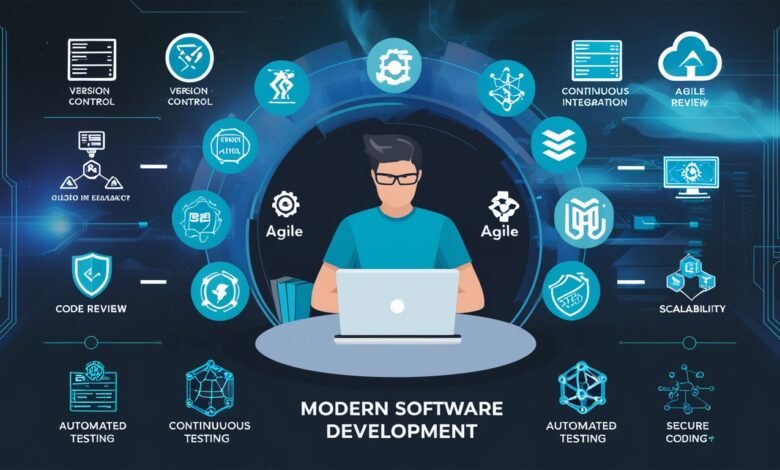12 Software Development Best Practices in 2024

12 Software Development Best Practices in 2024
Learn the top 12 software development best practices to follow in 2024 for optimized performance, security, and collaboration. Stay ahead in the fast-evolving tech industry.
Introduction:
Software development is rapidly evolving, driven by technological advancements, changes in market demand, and emerging methodologies. Staying ahead in 2024 requires technical expertise and adherence to industry best practices that ensure efficiency, security, and scalability. This article covers the 12 essential software development best practices to follow in 2024.
Here are 12 Software Development Best Practices in 2024:
1) Version Control:
Version control is the foundation of modern software development. Tools like Git allow developers to track changes, collaborate with other team members, and revert to previous code versions if something goes wrong. Version control enables:
- Collaboration:
Multiple developers can work on the same project simultaneously without overwriting each other’s changes. - Tracking Changes:
Every modification is tracked, making it easy to see who made what changes and when. - Easy Rollbacks:
If a bug or issue is introduced, developers can quickly revert the codebase to a previous stable version.
Version control also facilitates code branching, allowing developers to work on new features without affecting the main codebase. Once the new feature is ready and tested, it can be merged into the main branch, ensuring continuous progress without disrupting ongoing work.
2) Continuous Integration:
Continuous Integration (CI) is a development practice where developers integrate code into a shared repository several times daily. Each integration is verified by automated builds and tests, allowing teams to detect errors early. CI offers several benefits:
- Early Bug Detection:
Because code is integrated frequently, issues are identified and fixed earlier in development. - Faster Development:
CI automates testing and builds, enabling developers to release updates faster and more confidently. - Improved Collaboration:
Since developers frequently merge code into a shared repository, it encourages better collaboration and communication among team members.
Incorporating CI ensures that every change is tested and integrated correctly, reducing the likelihood of integration conflicts or significant issues later in the development lifecycle.
3) Design Before Coding:
Jumping straight into coding without a solid design can lead to significant problems. Proper planning and design help avoid costly rewrites and refactoring. Before writing a single line of code, developers should:
- Define the Architecture:
This ensures the software is scalable, maintainable, and meets performance requirements. - Identify Components:
Breaking the project into modular components makes developing, testing, and deploying individual parts easier. - Document the Design:
A well-documented design provides clarity for all team members and helps onboard new developers quickly.
Designing before coding also helps align the development team with project stakeholders, ensuring that the technical solution meets business requirements and future scalability needs.
4) Automated Testing:
Manual testing is time-consuming and prone to human error. Automated testing ensures that code is tested consistently across different scenarios and platforms, speeding up the development process while improving code quality. Automated testing provides:
- Speed:
Test suites can be run automatically with every code change, providing immediate feedback to developers. - Reliability:
Automated tests are more consistent and thorough than manual tests, helping catch more bugs early in the process. - Regression Testing:
Automated tests ensure that new changes don’t break existing functionality, maintaining the software’s stability over time.
Test-driven development (TDD) is another valuable practice in which developers write tests before writing the actual code. This ensures the code meets requirements and is testable from the beginning.
5) Code Review:
Code reviews are a crucial part of maintaining high code quality. By having peers review each other’s code, teams can identify bugs, inconsistencies, and performance issues before the code is merged into the main branch. Code reviews offer:
- Improved Code Quality:
A second set of eyes can catch mistakes or inefficiencies the original developer may have missed. - Knowledge Sharing:
Code reviews promote knowledge sharing across the team, helping junior developers learn from more experienced members. - Consistent Standards:
By reviewing code, teams ensure that the code adheres to project standards and guidelines, leading to a more uniform codebase.
Tools like GitHub and GitLab offer built-in code review features, enabling seamless feedback and collaboration between developers.

6) Testing:
Beyond automated testing, thorough manual testing is necessary to ensure the software works as intended. This includes unit tests, integration tests, performance tests, and user acceptance tests (UAT). Testing ensures:
- Functionality:
The software performs its intended functions correctly. - Performance:
The application can handle expected workloads without performance degradation. - Compatibility:
The software functions appropriately across different platforms, devices, and environments.
Testing should be continuous and occur throughout the development cycle. Frequent testing helps ensure that bugs are caught and fixed before they become major issues in production.
7) Define Requirements:
Defining clear and detailed requirements upfront is crucial to the success of any software project. Without a clear understanding of the project goals, developers may build a solution that doesn’t meet business or user needs. Well-defined requirements:
- Set Clear Goals:
Requirements provide a roadmap for developers, outlining precisely what the software should achieve. - Avoid Scope Creep:
When requirements are documented, it’s easier to prevent changes or additional features from being added mid-project, which can derail timelines. - Ensure Stakeholder Alignment:
The development team ensures everyone is aligned on the project goals and deliverables by documenting and reviewing requirements with stakeholders.
Collaborating with business analysts, product managers, and other stakeholders is critical to gathering accurate and complete requirements.
8) Prioritize Security:
In 2024, security cannot be an afterthought. With increasing cyber threats, developers must prioritize security throughout development. This involves:
- Secure Coding Practices:
Write code resilient to common security vulnerabilities such as SQL injection, cross-site scripting (XSS), and buffer overflows. - Regular Security Audits:
Conducting security audits and penetration testing to identify and fix vulnerabilities before exploitation. - Data Encryption:
Encrypting sensitive data in transit and at rest to protect it from unauthorized access.
By incorporating security into the development lifecycle, teams can prevent costly breaches and protect sensitive user data.
9) Test Code Frequently:
Frequent testing is essential to maintaining software quality. Running tests regularly helps catch bugs early and ensures the software remains stable as new features are added. Frequent testing also:
- Identifies Bugs Sooner:
Running tests with every code change helps identify bugs early, preventing them from becoming major issues. - Prevents Regressions:
Frequent tests ensure new code changes don’t break existing functionality. - Maintaining Code Quality:
Regular testing promotes cleaner, more maintainable code since developers know their code will be tested regularly.
Incorporating automated and manual tests into the development process ensures that the software remains reliable and performs as expected.
10) Agile Development:
Agile methodologies are essential for modern software development. Agile allows teams to work in short, iterative cycles, known as sprints, which enable continuous delivery of new features and improvements. Agile development provides:
- Flexibility:
Agile allows teams to respond quickly to changes in project requirements or market conditions. - Incremental Progress:
By breaking the project into smaller sprints, teams can focus on delivering high-value features incrementally rather than all at once. - Enhanced Collaboration:
Agile fosters communication between developers, designers, and stakeholders, ensuring everyone is aligned throughout the development process.
Popular Agile frameworks include Scrum, Kanban, and Extreme Programming (XP), each offering its approach to iterative development.
11) Choose the Right Methodology:
Choosing the proper development methodology is crucial to the success of a software project. Different projects require different approaches, and selecting the appropriate one ensures the development process is efficient and meets project goals. Key considerations include:
- Project Scope:
Agile methodologies are best for projects with changing requirements, while Waterfall might be more suitable for projects with clearly defined stages. - Team Structure:
The size and expertise of your team can influence which methodology works best. Agile works well for smaller, cross-functional teams, while larger teams may benefit from more structured methodologies like Waterfall. - Timeframe and Budget:
Some methodologies, such as Agile, allow for flexible scope and timelines, while others, like Waterfall, have strict deadlines and cost estimates.
Aligning the methodology with your project needs ensures that the team remains focused and productive and meets the project’s objectives.
12) Documentation:
Good documentation is critical for maintaining and scaling software projects. Documentation provides clarity for current team members and helps onboard new developers efficiently. Effective documentation includes:
- API Documentation:
Ensuring that all public interfaces and APIs are well-documented helps external developers use your software effectively. - Code Commenting:
Inline comments in the code help clarify complex logic and help other developers understand its thought process. - Project Documentation:
Maintaining a knowledge base or wiki with information about project architecture, processes, and decisions ensures the team can access necessary information.
Clear documentation also makes it easier to revisit and update code in the future, reducing the learning curve when changes are required.

Conclusion:
Following these 12 software development best practices in 2024, development teams can build more efficient, scalable, and secure software. These practices, from version control and continuous integration to security prioritization and Agile methodologies, help teams stay competitive in today’s fast-evolving tech landscape. Whether working on a startup project or managing an enterprise-level solution, adhering to these best practices will enhance collaboration, code quality, and overall software success.
FAQs
- What is version control, and why is it important in software development?
Version control allows developers to track changes, collaborate on code, and revert to previous versions when necessary. It’s essential for managing code across teams and preventing issues caused by conflicting changes. - What is the purpose of continuous integration?
Continuous Integration (CI) involves merging code changes into a shared repository multiple times a day. It helps catch bugs early, speed development, and reduce integration problems. - Why is automated testing necessary?
Automated testing ensures that code is consistently tested for errors across different environments. It speeds up the development process by reducing the need for manual testing and improves overall code reliability. - How does Agile development improve software projects?
Agile development allows teams to work in short, iterative cycles, delivering features incrementally and adapting quickly to changing requirements. It improves collaboration, flexibility, and the delivery of high-quality software. - Why should security be prioritized in software development?
Security must be integrated throughout the software development lifecycle to prevent vulnerabilities, protect user data, and ensure compliance with data protection laws. Prioritizing security from the beginning reduces the risk of costly data breaches.
Review this:




